Kids know: sharks are “cool”. It’s hardly surprising that there
are almost as many kids’ books about sharks as there are about
dinosaurs. Although most shark books for kids feature lots of glossy
photos and attractive diagrams, they vary enormously in the quality and
quantity of information they contain. Plus there’s the problem that a
book suitable for a six-year-old is probably of little use to a
ten-year-old and one suitable for a ten-year-old is probably of limited
use to a 12-year-old. Following are brief capsule reviews of some of the
best recent shark books for kids, arranged by age range of suitability
from youngest to oldest (Age Range given is for self-reading; if read
aloud with a parent’s help, younger children may get much out of a book
rated for older kids). To aid choosing a book suitable for a given reading
level, I am including a representative paragraph from each book reviewed.
Books are rated according to scientific accuracy of the text and
illustrations as well as the balance of and readability of their content.
Although the newest books are not always the best, I have chosen 1990 as
the arbitrary cut-off point for books included here. I hope that parents
will find this section of help when their little one has a sharky project
due or otherwise gets ‘turned onto’ the wonders of sharks. The
ten-year-old shark enthusiast of today may become the scientist of
tomorrow.
|
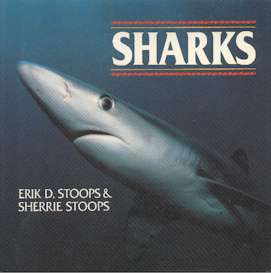




Sharks, by Erik D. Stoops and
Sherrie Stoops, 1994 (Sterling Publishing, New York)
Arranged in an easy-to-use question-and-answer format, this book
offers brief, easy-to-read answers to just the sort of questions
kids ask (“Do sharks throw up?”) as well as many that they might not
have thought of yet but are nonetheless important to understanding
sharks as animals (“How does the lateral line work?”). The
information is generally accurate and always very clearly presented.
Includes many beautiful photos with informative captions. Of special
note are the elegant anatomical diagrams of illustrator Jeffrey L.
Martin, which are accurate and informative. Perhaps the most
remarkable feature of this book is that it can be used and enjoyed
by kids with widely differing reading skills (school librarians,
take note). Includes index. Age Range: 6-12.
Sample Text: "Are sharks smart? Yes,
experiments show that they can recognize and remember patterns and
shapes. Lemon Sharks have been taught to ring bells, press
targets and even swim through mazes to receive rewards of
food."
[Back to the book list] [Top]
|
|
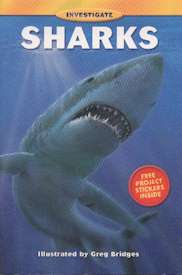
  
Investigate Sharks,
by Greg Pyers, 2000 (Whitecap Books, North Vancouver).
Originally produced by Random House Australia, this colorful
little book really showcases the wondrous diversity of sharks,
depicting many species not usually included in popular shark books.
The text is crisply written and generally accurate. The
illustrations by Greg Bridges are dynamic and - barring distortions
for dramatic effect - often astoundingly accurate, giving a real
sense of how living sharks look and behave. Scattered throughout the
book are bubbles labeled "Look Again" which pose questions
that extend the text or invite discovery through closer examination
of the illustrations. The center of the book includes a removable
sheet of 8 shark stickers reproduced from the book, which could be
used to illustrate a school project, and the back of the book
includes brief instructions for making one's own cuddly shark toy.
Includes a glossary, list of books and websites for further
information, and an index. Age Range: 8-10. Sample Text: "Are they man-eaters? Great
white sharks have a reputation as 'man-eaters' and it is true that
they have attacked and killed humans off the coasts of California,
Australia, New Zealand and South Africa. However, these
attacks are extremely rare. In fact, many more great whites
are killed by humans every year, so much so that the future survival
of this species is under threat."
[Back to the book list] [Top]
|
|
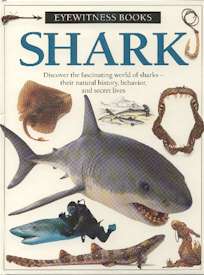
   
Eyewitness Books: Shark,
by
Miranda MacQuitty, 1992 (Dorling Kindersley, London).
Packed with gorgeous, full-color photos and fascinating tidbits
of information, this is a terrific book for browsing. As with other
volumes in the series, this book resembles an exceptionally rich
museum exhibit between covers. All the essential information about
sharks is here: definition, relatives, evolution, anatomy, swimming,
senses, reproduction, feeding, enemies and profiles of many of the
more interesting species. But, in addition to the obligate sections
on shark attacks and safety, the book also includes shark artifacts,
studying sharks, commercal exploitation of sharks, and shark-related
projects for readers to try. Numerous quaint antiquarian
illustrations, artifacts, and factoids are among the most unusual
aspects of this book. In fact, there are so many odd surprises among
this books pages, I keep a copy within easy reach should I need one
or two to enliven my own writing. Includes an index. Age Range:
10-14. Sample Text: "Bark Painting. The Australian
Aborigines painted designs on pieces of bark cut from trees.
In their paintings, they often reveal what is inside an
animal. In this 20th-century bark painting (left), the painter
shows the shark's liver, which has two large lobes."
[Back to the book list] [Top]
|
|

    
Reader's Digest Pathfinders:
Sharks and Other Sea Creatures,
by Leighton Taylor, 2000
(Reader's Digest, Pleasantville).
Originally produced by Weldon Owen of Australia, this
large-format book features gorgeous full-color illustrations by many
of the finest wildlife illustrators, including Martin Camm, Marc
Dando, and Roger Swainston. The text is accurate and easy-to-read,
broken into bite-sized chunks. Special features include Word
Builders (etymology), Pathfinder (links to related topics in the
book), and That's Amazing (surprising factoids). Other nice
additions are Close Encounters, which introduce selected shark
researchers, and Things to Do, which suggests simple experiments to
illustrate principles introduced in the text. The book is divided
into three main sections, Introducing Sharks (origin,
classification, and diversity), Shark Works (anatomy and
physiology), and A Shark's World (ecology and conservation).
Overall, this is a splendid first introduction to sharks in the
context of how they earn a living in the sea, punctuated with many
fun and creative pedagogical features. Includes a good glossary and
index. Age Range: 10-12. Sample Text: "Ramming in Oxygen. Large,
fast-swimming sharks such as makos and great whites (above) need
plenty of oxygen in order to push their muscles harder. This means
they must force large volumes of water over their gills. By
swimming fast with their mouths barely open, they can force
oxygen-containing water over their gills. This process is
called ram ventilation."
[Back to the book list] [Top]
|
|

  
Nature Watch: Sharks,
by
Michael Bright, 2000 (Hermes House, London).
For the most part, the contents of this book are unremarkable,
only occasionally including some fact or idea that is not in just
about every other shark book. Yet the contents are remarkable in one
very important respect: in virtually every instance where most
popular shark books get a fact not-quite-right, this book gets it
exactly right. This unusually high degree of scientific accuracy is
undoubtedly due to consultant Ian K. Fergusson of the Shark Trust, a
U.K.-based shark research and conservation organization. The photos
are uniformly excellent, although many have shown up in countless
other shark books and some are cropped very oddly. Had this book had
at least one fresh approach to the subject, I would have rated it
higher. But there's no question this is as accurate an introduction
for kids as one is likely to find. Includes a glossary and index.
Age Range: 10-12. Sample Text: "Suspended Animation. The
sandtiger shark (Carcharias taurus) and a few others can hold
air in their stomachs. The air acts like a life jacket,
helping the shark to hover in the water. Sandtiger sharks stay
afloat without moving, lurking among rocks and caves."
[Back to the book list] [Top]
|
|
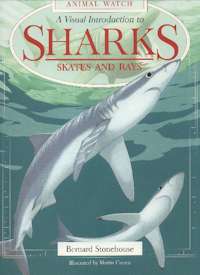    
A Visual Introduction to Sharks,
Skates and Rays, by Bernard Stonehouse, 1999 (Checkmark Books,
New York).
Featuring the beautiful and accurate full-color illustrations of
Martin Camm, this book is a visual feast. But, as importantly, the
text by zoologist Stonehouse is both accurate and up-to-date. In
attractive two-page spreads, sharks and their flattened cousins, the
skates and rays, are characterized, they are compared with teleost
(bony fishes), their diversity, anatomy, and distribution is
explored. Each major taxonomic group is surveyed in their presumed
phylogenetic (evolutionary) order. Skates and rays are covered in a
single spread, which does not do justice to their beauty and
diversity. The book concludes with a spread on the danger posed by
and to sharks. To help young shark enthusiasts conquer some
jaw-breaking technical terms, phonetic pronunciation guides appear
throughout the text. Includes a brief glossary and index. Age Range:
10-12. Sample Text: "Growing Up. Many sharks start
life as eggs, from which baby sharks emerge after several
months. Baby sharks look after themselves independently from
the moment of hatching or birth. They grow very slowly.
Almost every species takes several years to reach maturity and to be
able to reproduce. Then they continue growing, even more
slowly, probably until they die. How do we know how old they
are? Some species add a ring of growth to their vertebrae
every year. Others have been tagged and measured in the wild,
then caught later and measured again."
[Back to the book list] [Top]
|
|
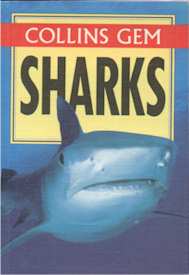
   
Collins Gem: Sharks,
by
Geoffrey W. Potts and Silja Swaby, 1997 (Harper Collins, Glasgow).
A concise, pocket-sized guide, this book describes and
illustrates some 240 species of sharks and rays from around the
globe. A brief introduction to sharks and rays a followed by
profiles of selected species. Species profiles feature one or more
full-color illustrations by Sean Milne, introductory remarks, and
basic information divided into Size, Distribution, Food, Breeding,
and Danger to Humans. The text is generally accurate (if a little
dated in places) and Milne's illustrations are accurate and
attractive, including lateral profiles and more elaborate paintings
depicting sharks and rays in their natural habitats. The species
profiles are arranged in evolutionary order and the tops of the
pages are color-coded by major taxonomic group. This little book
really showcases the diversity of form, pattern, and color exhibited
by sharks and rays. Includes suggestions for further reading, a
glossary, and an index to species. Age Range: 12-14+. Sample Text: "Sandtiger Shark Eugomphodus taurus.
A large, heavy-bodied sharks with a mouth containing conspicuous
teeth giving it the alternative name of Snaggle-tooth Shark.
The body is mostly pale brown, but spotted individuals have been
recorded. This species is common singly, or in large schools,
in inshore waters over coral and rocky reefs where it is most active
at night."
[Back to the book list] [Top]
|
|
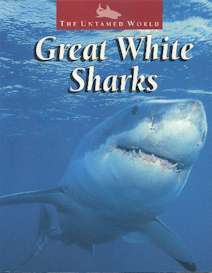
   
Great White Sharks,
by Marie
Levine, 1998 (Weigel Educational Publishers, Calgary)
Written in clean, elegant prose, shark researcher Marie Levine
has done a splendid job summarizing many of the latest findings
about the celebrated Great White Shark. With admirable brevity,
Levine covers the basics of the White Shark's ancestry,
classification, size, shape, coloration, special adaptations,
senses, body language, mating, development and birth, habitat, food,
hunting, role in ocean ecology, distribution, status and
conservation. She also discusses how the Great White is studied in
the wild and in captivity, its role in folklore, and what readers
can do to help protect this rare and spectacular predator. Levine
presents some rather sophisticated concepts in deceptively simple
language. The photographs and diagrams are informative and include
few of the many 'overused' images found in just about every other
shark book. Includes glossary, suggested readings, and index. Age
Range: 12-14. Sample Text: "Not long ago scientists thought
great white sharks were solitary animals that lived and hunted
alone. Scientists are now learning that great white sharks are
social animals. They form complex relationships and use body
language to communicate."
[Back to the book list] [Top]
|
|
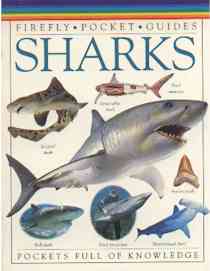
   
Firefly Pocket Guide: Sharks,
by Joyce Pope, 1997 (Firefly Books, Willowdale).
Produced by Dorling Kindersley of London, this little book is
great for exploring sharks by people with big imaginations and
little hands. Profusely illustrated with clear, informative photos
and diagrams, the text is divided into bite-sized sections and
organized into seven main sections: Introduction, Anatomy, Living
and Surviving, Sharks and Humans, Shark Directory, Sharks for the
Future, and a Reference Section. An astonishing amount of good,
solid information is packed into a compact product of 128 pages,
including Shark Records, Places You Can See Sharks, and
Organizations Interested in Sharks. Includes a glossary, suggested
readings, and an excellent Index. Age Range: 12-14. Sample Text: "All animals live to rhythms dictated
by the sun and the seasons. These are translated into patterns
of behavior such as sleeping, breeding, and migrating. Even
the lives of deep-sea sharks are regulated by their body
clocks."
[Back to the book list] [Top]
|
|
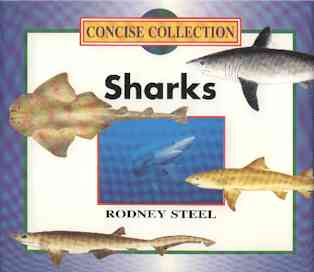
  
Concise Collection: Sharks,
by
Rodney Steel, 1995 (Grange Books, London).
After a brief, one-page introduction to sharks, this book offers
detailed profiles of 40 selected shark species, arranged in
alphabetical order by vernacular name. The text, by vertebrate
paleontologist Steel, is generally quite accurate. The illustrations
are uniformly very good to excellent. Some choices of vernacular
name are at odds with common usage, which could create difficulties
in looking up a particular species. The single biggest flaw of this
book is that the Megamouth and Luminous (=Cookiecutter) shark
illustrations have been swapped and some of the photos do not depict
the species under discussion in the text. Age Range: 12+. Sample Text: "On fine days porbeagles are
frequently seen near the surface, swimming with the dorsal fin
exposed. They provide indifferent sport, proving sluggish when
hooked and never jumping. Additional species of porbeagle
occur in the Pacific."
[Back to the book list] [Top]
|
| To Purchase
Any of These Books:
Please contact your local, Independent
Bookseller about Special Ordering
the book(s) you want. Independent Booksellers are the
life's blood that keeps publishers and authors in Business;
they need and deserve your support.
Otherwise, try: Natural History Book Services,
Amazon.com
or Barnes
and Noble |
| If You'd Like One of Your Books
Reviewed Here:
Publishers who would like one of their books reviewed here are
invited to contact
R. Aidan Martin directly to arrange for a review copy. The only
condition is that Aidan be free to express his honest, unadulterated
opinion about any book submitted for review. |










